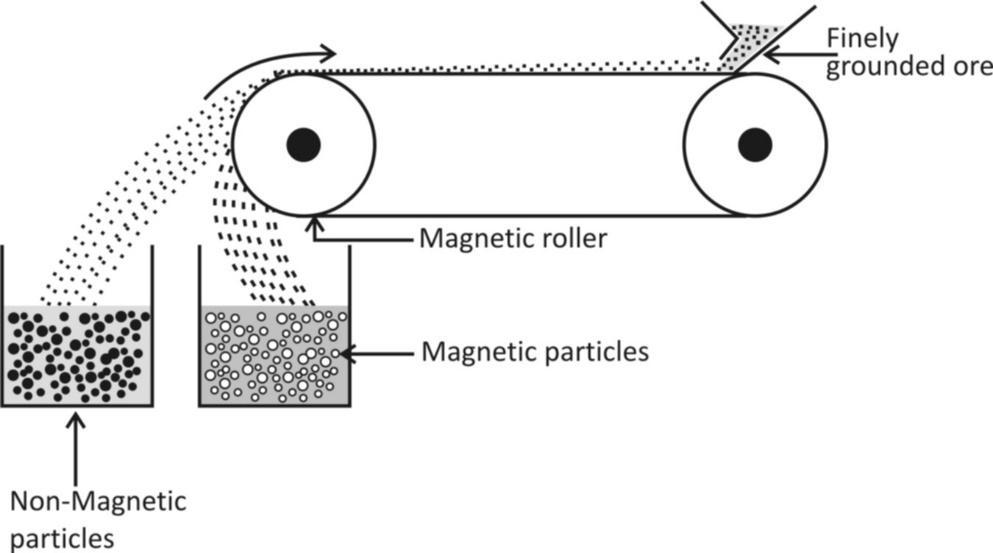
Explain magnetic separation process of ores with the help of a neat labelled diagram.
Answer
473.7k+ views
Hint: Magnetic separation is the technique useful for few minerals such as ferromagnetic and paramagnetic. Ferromagnetic substances are the substances strongly affected by magnetic fields. Paramagnetic substances are the substances less affected by magnetic fields.
Complete step by step answer:

Construction –
An electromagnetic separator requires a leather or brass belt that moves over two rollers one of the roller encloses magnet in it.
Working –
(1) Slowly drop finely grounded particles on the moving belt at one end.
(2) Start rolling the moving belt with the help of two rollers.
(3) The non – magnetic particles of the ore are not attracted by the magnet and flats to do a separate heap at a distance.
(4) The magnetic particles of the ore clings to the belt for a longer distance and forms another heap near the magnet.
Conclusion – the magnetic particles and non – magnetic particles can be finely separated with the help of magnetic property i.e. magnetic attraction.
Example – Non – magnetic tin oxide (SnO) can be separated from magnetic $FeW{O_4}$ present in the ore cassiterite by magnetic separation process.
Note:
The magnetic separation ore is used in scrap yards. Magnetic operation was developed in $1970$with new technologies these new technologies of magnetic separation included magnetic pulleys, overhead magnets and magnetic drums. These technologies are used in the recycling industry.
This technique is also used in industries to remove metal contaminants from product streams. Magnetic separation is also used in dairy, grain and milling, plastics, food, chemical, oils, textile and many more industries, magnetic separation is also used in situations where pollution needs to be controlled in chemical processing as well as the benefaction of non – ferrous low grade ores.
Complete step by step answer:

Construction –
An electromagnetic separator requires a leather or brass belt that moves over two rollers one of the roller encloses magnet in it.
Working –
(1) Slowly drop finely grounded particles on the moving belt at one end.
(2) Start rolling the moving belt with the help of two rollers.
(3) The non – magnetic particles of the ore are not attracted by the magnet and flats to do a separate heap at a distance.
(4) The magnetic particles of the ore clings to the belt for a longer distance and forms another heap near the magnet.
Conclusion – the magnetic particles and non – magnetic particles can be finely separated with the help of magnetic property i.e. magnetic attraction.
Example – Non – magnetic tin oxide (SnO) can be separated from magnetic $FeW{O_4}$ present in the ore cassiterite by magnetic separation process.
Note:
The magnetic separation ore is used in scrap yards. Magnetic operation was developed in $1970$with new technologies these new technologies of magnetic separation included magnetic pulleys, overhead magnets and magnetic drums. These technologies are used in the recycling industry.
This technique is also used in industries to remove metal contaminants from product streams. Magnetic separation is also used in dairy, grain and milling, plastics, food, chemical, oils, textile and many more industries, magnetic separation is also used in situations where pollution needs to be controlled in chemical processing as well as the benefaction of non – ferrous low grade ores.
Recently Updated Pages
One difference between a Formal Letter and an informal class null english null

Can anyone list 10 advantages and disadvantages of friction

What are the Components of Financial System?

How do you arrange NH4 + BF3 H2O C2H2 in increasing class 11 chemistry CBSE

Is H mCT and q mCT the same thing If so which is more class 11 chemistry CBSE

What are the possible quantum number for the last outermost class 11 chemistry CBSE

Trending doubts
The reservoir of dam is called Govind Sagar A Jayakwadi class 11 social science CBSE

What is the chemical name of Iron class 11 chemistry CBSE

The dimensional formula of dielectric strength A M1L1T2Q class 11 physics CBSE

The members of the Municipal Corporation are elected class 11 social science CBSE

What is spore formation class 11 biology CBSE

In China rose the flowers are A Zygomorphic epigynous class 11 biology CBSE




